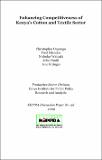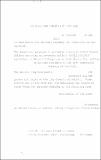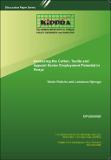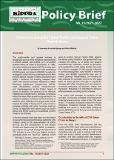| dc.description.abstract | Cotton farming is a major source of livelihood for rural households in Kenya. It is characterized by a large number of small holder farmers, hence making it a priority crop for improving livelihood and reducing poverty. Besides, value added activities along the cotton value chain have potential for creating new jobs for semi and unskilled workers. Concerns about declining performance of the sector after liberalization of Kenya’s economy in the 1990’s generated efforts towards its revitalization and sustainable development. Domestically, the key issues have been high costs of inputs, particularly fertilizers and agrochemicals, supply of poor quality seed cotton, dilapidated and old machineries and weak institutional and commercial linkages. At the global level, cotton production and trade is highly distorted by subsidies particularly by the large players like the United States, China and the European Union. These and other factors have depressed domestic cotton productions leading to losses in incomes, unemployment and under utilized capacities. This study evaluated the cotton sector as an integrated production network where production is sliced into specialized activities and each activity is located where it can contribute the most to the value of the product. In this framework, institutional and governance structures are assumed to play a critical role in determining information flow about production and market attributes along the cotton value chain. The study established that opportunities for value adding activities exist at the four basic levels of the value chain; production, ginning, milling and markets. Furthermore, although Kenya has limited scope in the use of tariff measures due to existing trade commitments, simulation results indicate that increasing currently applied tariffs on imported textile products by 100 per cent can curb competitive pressure from
imported cotton products, thereby encouraging increased domestic cotton production and capacity utilization. However, this requires appropriate product market regulations and incentives to generate trickle down effects by stimulating production of intermediate inputs and services along the value chain. | en |




